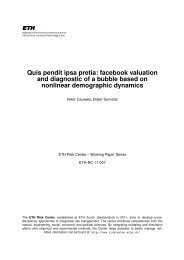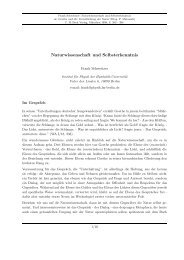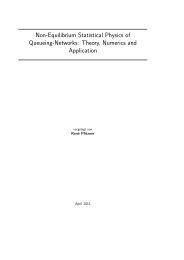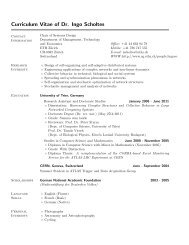Using Laboratory Experiments to Study Law and Crime - Chair of ...
Using Laboratory Experiments to Study Law and Crime - Chair of ...
Using Laboratory Experiments to Study Law and Crime - Chair of ...
Create successful ePaper yourself
Turn your PDF publications into a flip-book with our unique Google optimized e-Paper software.
It is possible that we could see consistent findings across settings just by coincidence.But, such a conclusion would require us <strong>to</strong> accept the existence <strong>of</strong> a lot <strong>of</strong> coincidence in theworld (Guala 2002: 263). Most <strong>of</strong> the time, consistent results are not the result <strong>of</strong> coincidence.We can therefore identify three conditions for drawing internally <strong>and</strong> externally valid causalinferences from data collected in both the field <strong>and</strong> the labora<strong>to</strong>ry: First, we have a theory thatidentifies a mechanism connecting a causal fac<strong>to</strong>r with an outcome. Second, we have evidencefrom the field that there is a correlation between the causal fac<strong>to</strong>r <strong>and</strong> the outcome. Third, wehave evidence <strong>of</strong> a mechanism linking the causal fac<strong>to</strong>r <strong>and</strong> the outcome in the labora<strong>to</strong>ry. Ifthese conditions are met, it is reasonable <strong>to</strong> think that the mechanism that operates in thelabora<strong>to</strong>ry is also operating in the field.SUMMARY<strong>Experiments</strong> are particularly well-suited for disentangling causal relations <strong>and</strong> causalmechanisms. Other methods have other strengths. For example, surveys are very useful fordescribing the distribution <strong>of</strong> behaviors in a sample <strong>and</strong>, if the sample is well-constructed, forgeneralizing it <strong>to</strong> a larger population. Further, using sophisticated statistical techniques <strong>and</strong>survey methods, criminologists have been successful at identifying correlations <strong>and</strong> causalrelations. Qualitative methods provide in-depth underst<strong>and</strong>ing <strong>of</strong> particular settings <strong>and</strong> canproduce new insights <strong>and</strong> hypotheses about important social processes. Integrating thesemethods will allow us <strong>to</strong> take advantage <strong>of</strong> the strengths <strong>of</strong> each. Integration may involvereporting the results <strong>of</strong> multiple methods in a single paper. But it may also involve publishingpapers based on labora<strong>to</strong>ry experiments, papers based on surveys, <strong>and</strong> papers based onqualitative methods – with the authors <strong>of</strong> each building on the knowledge gained from theothers.To illustrate how data from labora<strong>to</strong>ry experiments <strong>and</strong> other methods may <strong>to</strong>getherincrease our underst<strong>and</strong>ing more than a single method alone, we focus on three issues in the10







